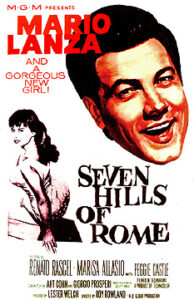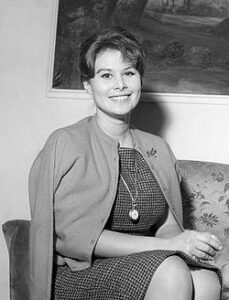Seven Hills of Rome ** (1957, Mario Lanza, Renato Rascel, Marisa Allasio, Peggie Castle) – Classic Movie Review 11,684

Director Roy Rowland’s 1957 Italian-American film international co-production The Seven Hills of Rome [Arrivederci Roma] stars the troubled Mario Lanza, in his movie comeback, as an American TV singing star called Marc Revere who goes to Rome to find his jet-setting fiancée, Carol Ralston (Peggie Castle). He moves in with his struggling artist cousin Pepe Bonelli (Renato Rascel), quarrels with his fiancée, and falls in love with Raffaella Marini (Marisa Allasio), the young Italian beauty he met on a train.
The Seven Hills of Rome is routine stuff with pretty locations, beautiful cinematography in Technicolor and Technirama by Tonino Delli Colli, a slight plot (story by Giuseppe Amato) and an underpowered production.
Lanza is in good voice and, unexpectedly, performs some funny take-offs of 50s pop singers (Perry Como, Frankie Laine, Dean Martin and Louis Armstrong). Opera selections include ‘Questa o quella’ from Rigoletto.
The music is supervised and conducted by George Stoll.
The cast are Mario Lanza, Renato Rascel, Marisa Allasio, Peggie Castle, Rossella Como as Anita, Amos Davoli, Marco Tulli as Romoletto, Carlo Giuffré as Franco Cellis, Adriana Hart, Paddy Crean as Mr Fante, Stuart Hart, Clelia Matania as Beatrice, Carlo Rizzo as Club Ulpia Director, Guido Celano as Luigi, and Anna Maria Saritelli as Extra
Seven Hills of Rome was shot on location in Rome and at the Titanus studios in Rome and released in Italy on 21 November 1957 and in the US by MGM on 30 January 1958.
It is Lanza’s penultimate film. Lanza died in Rome of an apparent pulmonary embolism aged 38 on 7 October 1959 after undergoing a controversial weight loss programme. The Italian title of Arrivederci Roma was going to be the American title of a film Lanza was scheduled to make in 1960.
It is sex symbol Allasio’s last film. She abandoned her film career in 1957 on marrying Count Pier Francesco Calvi di Bergolo, son of Princess Iolanda di Savoia, first-born of Vittorio Emanuele III and Elena del Montenegro.
The screenplay is by Giorgio Prosperi and Art Cohn, who died two months after the film’s release in the plane crash that killed producer Mike Todd, whose biography Cohn was writing.
The film did well, earning $2,155,000 and making a profit of $162,000 for MGM.
The seven hills of Rome east of the River Tiber form the geographical heart of Rome within the walls of the city. Five of the seven hills – the Aventine, Caelian, Esquiline, Quirinal and Viminal Hills – are now the sites of monuments, buildings and parks.
© Derek Winnert 2021 Classic Movie Review 11,684
Check out more reviews on http://derekwinnert.com



